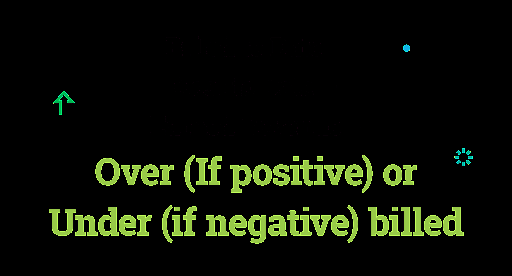Maintaining profits and keeping jobs on track is not easy in the construction industry. With bills to pay, materials to order, teams to manage, and countless other tasks, effective financial management is crucial. That’s where accurate, real-time Work in Progress (WIP) reporting comes into play. Are you leveraging WIP reports to their full potential? In this comprehensive guide, we’ll explore everything you need to know about WIP reporting and how it can set your construction projects and business up for success.
Key Takeaways
- Understand the definition and importance of WIP in construction accounting.
- Learn how to calculate WIP and interpret overbilling and underbilling.
- Discover the essential elements of a WIP report.
- Explore common mistakes to avoid when creating WIP reports.
- Find out how construction accounting software can enhance WIP reporting.
- Get practical examples and case studies to apply WIP reporting effectively.
What is Work In Progress (WIP)?
Work in Progress (WIP) is a critical component of construction accounting. It represents the total value of all ongoing construction projects that are not yet completed. WIP encompasses costs incurred, revenue recognized, and the percentage of project completion. Understanding WIP allows construction firms to manage budgets effectively, anticipate potential overruns, and maintain financial health.
Importance of WIP Reporting
WIP reporting is essential for several reasons:
- Financial Management: Provides insights into project costs versus budgeted amounts, enabling proactive management.
- Cash Flow Management: Helps predict cash flow needs, avoiding liquidity issues.
- Project Performance Tracking: Assesses project performance against timelines and budgets, facilitating timely interventions.
- Stakeholder Communication: Enhances communication with stakeholders regarding project status and financial health.
How to Calculate Work In Progress (WIP)
Calculating WIP involves several steps to determine the financial status of ongoing projects. Here’s how you can calculate WIP effectively:
Step 1: Determine Total Costs Incurred
Sum all costs associated with the project up to the reporting date, including labor, materials, and overhead.
Step 2: Estimate Percentage of Completion
Use methods such as cost-to-cost, units-of-delivery, or cost-to-finish to estimate the percentage of work completed.
Step 3: Calculate Revenue to Recognize
Use the formula:
Revenue Recognized = Total Contract Value × Percentage of CompletionStep 4: Assess Over or Underbilling
- If revenue recognized exceeds billed amounts, it indicates underbilling.
- If billed amounts exceed recognized revenue, it suggests overbilling.
What Information Should Be Included in a WIP Report?
A comprehensive WIP report should include the following key elements:
- Contract Value: The current total value of the contract.
- Revenue Recognition: Revenue received up to the present date.
- Initial Cost Projections: Original cost estimates to compare against current financials.
- Billing Information: Total amount billed to date.
- Revised Cost Estimates: Updated cost projections reflecting adjustments.
- Project Completion Percentage: Percentage of work completed so far.
- Actual Costs to Date: Summary of real costs incurred up to date.
- Billing Status: Assessment of whether the project is currently overbilled or underbilled.
Overbilling and Underbilling: Impact on Construction Projects
Understanding overbilling and underbilling is crucial for managing the financial aspects of construction projects:
Overbilling
Overbilling occurs when the amount billed exceeds the value of work completed. While it can temporarily boost cash flow, it may indicate that the project is progressing slower than anticipated. This discrepancy can lead to financial strain if contractors cannot fund upcoming project stages.
Underbilling
Underbilling happens when the billing is less than the earned value of the work completed. This often results in negative cash flow, forcing contractors to self-finance the remainder of the project. Underbilling can lead to cash shortages, making it difficult to cover ongoing expenses and potentially jeopardizing project completion.
To determine whether a project is over or underbilled, you’ll need to know the projected cost at completion or revised estimate. Once you have this, you can calculate the percentage of work completed to date and the earned revenue to date.

Common Methods to Calculate WIP
There are three primary methods used to calculate WIP:
1. Percentage Complete
This method involves tracking progress using the estimated percentage of completion to calculate the revised total estimated cost. It’s ideal for projects where progress can be measured in percentages.
2. Units Complete
Compare the number of units completed with the total units budgeted to determine the percentage complete. This percentage is then used to calculate the revised estimate, suitable for projects quantifiable in discrete units.
3. Cost-to-Finish
Add the total amount spent to date to the estimated cost to finish, providing a straightforward calculation for revising the budget. This method is particularly useful for projects where financial metrics are the primary focus.
How Construction Accounting Software Can Help with WIP Reporting
Construction accounting software can significantly enhance WIP reporting by offering several key benefits:
- Automating Data Processes: Reduces manual data entry and errors, ensuring accurate and reliable WIP reports.
- Real-Time Project Insights: Provides up-to-date information on project progress, budgets, and timelines, enabling informed decision-making.
- Early Problem Identification: Highlights potential issues early, allowing for timely interventions to prevent delays and protect profit margins.
- Streamlining WIP Reports: Automates the generation of WIP reports, saving time and ensuring consistency.
- Enhancing Accuracy and Efficiency: Minimizes errors and speeds up report generation, allowing more focus on project management.
When selecting construction accounting software, ensure it fits your specific needs to maximize these benefits and keep your projects on track.
What to Look for When Selecting Construction Accounting Software
Choosing the right construction accounting software involves focusing on several key features:
- Project Management Capabilities: Simplifies the initiation of new projects and monitors ongoing tasks seamlessly.
- Comprehensive Accounting Integration: Offers full integration for all accounting functions like payroll, accounts payable, and receivable.
- Document Generation: Easily generate essential documents such as invoices, bills, purchase orders, and work orders.
- Flexibility and Scalability: Adapts to your changing business needs and increased workloads as your business grows.
- Real-Time Expense Tracking: Keeps track of expenses as they occur, providing insights into spending at any moment.
- Detailed Reporting Options: Offers comprehensive reporting features, including individual reports and overall WIP reports.
- Process Streamlining: Enhances efficiency by streamlining workflows and processes throughout project phases.
- Data Integration Across Modules: Ensures seamless data integration across different modules, avoiding redundant manual entry.
By prioritizing these elements, you’ll find software that not only meets but exceeds your construction accounting needs, ultimately contributing to smoother operations and better financial management.
Case Study: Effective Use of WIP Accounting in Construction
Let’s explore a case study that exemplifies the interconnection between WIP accounting practices and the utilization of a WIP schedule in construction.
Concrete Crew’s Approach
Concrete Crew, a concrete subcontractor, implements WIP accounting as an integral component of their financial management system. The firm generates a WIP schedule monthly, aligning with their payment application cycle, reflecting industry-standard WIP accounting principles.
Using WIP accounting standards, Concrete Crew meticulously records and tracks the direct costs of materials, labor, and overhead attributable to their projects, Job A and Job B. They recognize these costs as they are incurred, consistent with the accrual basis of accounting. This approach matches the revenue earned with the expenses incurred during the same period, providing a more accurate picture of project profitability.
Job A Analysis
Job A has a revised budget of $100,000 and a revised contract amount of $150,000. With a job-to-date (JTD) cost of $80,000 and a completion percentage of 80%, the earned revenue is $120,000. However, billing to date is only $75,000, resulting in an underbilling of $45,000. This discrepancy indicates that while the work is nearly complete, billing has lagged. A forthcoming change order stalls further billing until November, affecting cash flow management. This situation emphasizes the need to navigate through this period without compromising the company’s financial stability.
Job B Analysis
Similarly, Job B shows a revised budget of $100,000 and a revised contract amount of $150,000. The job is also 80% complete, with earned revenue of $120,000. The billed amount to date is $125,000, indicating an overbilling of $5,000. The WIP report notes that the project is on hold until Spring 2024, and the billing status will remain unchanged for now.
Concrete Crew’s application of WIP accounting, reflected in their monthly WIP schedule, serves as a vital instrument for fiscal oversight and strategic financial planning. It helps the business identify and adjust to underbilling and overbilling situations, thereby securing cash flow and preserving client relationships.
Common WIP Report Mistakes to Avoid
WIP reports are only reliable when used correctly. Avoid the following common mistakes to ensure your WIP reports provide accurate and actionable insights:
- Not Tracking Committed Costs: Committed costs, such as employee wages or material costs committed through purchase orders, need to be accurately tracked to ensure project profitability and accurate WIP reports.
- Entering Figures Incorrectly: Human errors like missing a zero or misentering numbers can greatly impact WIP data and subsequent calculations. Double-check entries for accuracy.
- Not Running Regular WIP Reports: Regular WIP reports are essential to keep track of project progress and financial health. Infrequent reporting can lead to budget exhaustion before issues are identified.
- Using Overbilling as Profit: Overbilling should not be treated as profit but as cash flow for future scheduled work. Misusing overbilled funds can leave projects without necessary funds to continue.
- Not Linking WIP with P&L Statements: Ensure that overbilling and underbilling amounts are reflected in the Profit and Loss statements and balance sheets to provide an accurate financial snapshot.
- Delayed Tracking of Expenses and Costs: Tracking expenses and costs in real-time ensures that all financial data is current. Delays can result in inaccurate budgets and misinformed decision-making.
Frequently Asked Questions (FAQs)
What is included in a WIP report?
A WIP report includes contract value, revenue recognition, initial cost projections, billing information, revised cost estimates, project completion percentage, actual costs to date, and billing status (overbilled or underbilled).
How can construction accounting software help with WIP reporting?
Construction accounting software automates data processes, provides real-time project insights, identifies problems early, streamlines WIP report generation, and enhances accuracy and efficiency, thereby improving WIP reporting.
What should you look for when selecting construction accounting software?
When selecting construction accounting software, consider project management capabilities, comprehensive accounting integration, document generation, flexibility and scalability, real-time expense tracking, detailed reporting options, process streamlining, and data integration across modules.
Why might contractors consider upgrading from generic accounting software for construction-specific needs?
Contractors should upgrade to construction-specific accounting software for enhanced job costing, streamlined project management, specialized reporting tools, construction-friendly payroll services, increased efficiency and accuracy, tailored to meet the unique needs of construction projects.
How often should you run a WIP report for optimal project management?
The frequency of running WIP reports depends on your business goals. For fast-paced environments, weekly reports are ideal. For stable, longer-term projects, monthly reports are suitable. Some businesses may opt for quarterly or end-of-project reports. It’s best practice to create both a company-wide WIP report and individual reports for each job.
Conclusion
Effective Work in Progress (WIP) reporting is essential for maintaining profitability and managing construction projects efficiently. By understanding the components of WIP, implementing accurate calculation methods, and utilizing specialized construction accounting software, construction firms can enhance their financial management and project oversight. Avoid common mistakes and leverage the right tools to ensure your projects stay on track and your business remains financially healthy.
Ready to optimize your WIP reporting and take control of your construction projects? Contact XOA TAX today at +1 (714) 594-6986 or email us at [email protected] to learn how we can help you streamline your construction accounting and improve your project management.
People Also Read




 anywhere
anywhere  anytime
anytime